German Language Levels for Visas: A1 vs. B2 for the Opportunity Card Explained
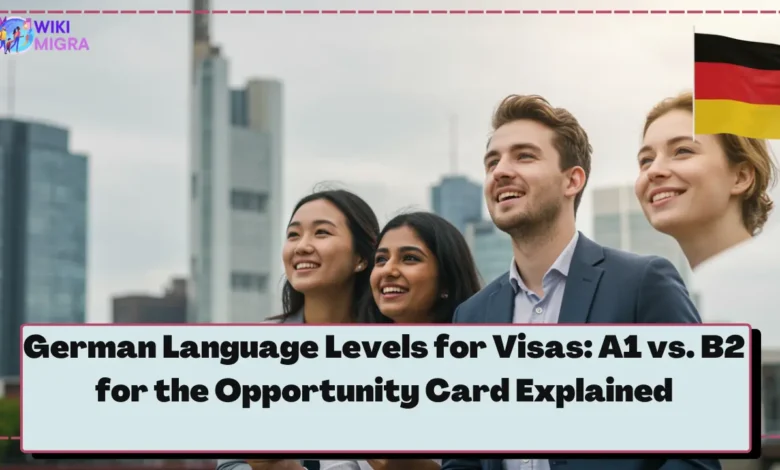
So, you’ve set your sights on Germany, the land of innovation and incredible career prospects. The German Opportunity Card is likely high on your list – a fantastic pathway for skilled individuals to seek employment in Germany. As you explore the criteria, a critical area often sparks questions: the Opportunity Card language requirements. What specific German A1 level is acceptable, or can proving English B2 for a German visa suffice? Crucially, how does a higher German B2 level, or even C1, enhance your application for the Chancenkarte?
Navigating German visa prerequisites, especially the Opportunity Card language requirements, can feel complex. But fear not! We’re here to demystify the language skills needed for the German Opportunity Card. Understanding these isn’t just about meeting a bureaucratic need; it’s about positioning yourself for success in your German job hunt and integration. This post specifically deciphers the German language levels for visas, tailored to the Opportunity Card.
For a holistic view of the Opportunity Card, including all eligibility factors and the complete points system, ensure you visit our cornerstone resource: [Pillar Page: Your Ultimate Guide to the German Opportunity Card]. This article specifically unpacks the language component.
Let’s decode those CEFR levels and understand their impact on your Opportunity Card language requirements.
Understanding CEFR Language Levels (A1, B2, C1) for Germany
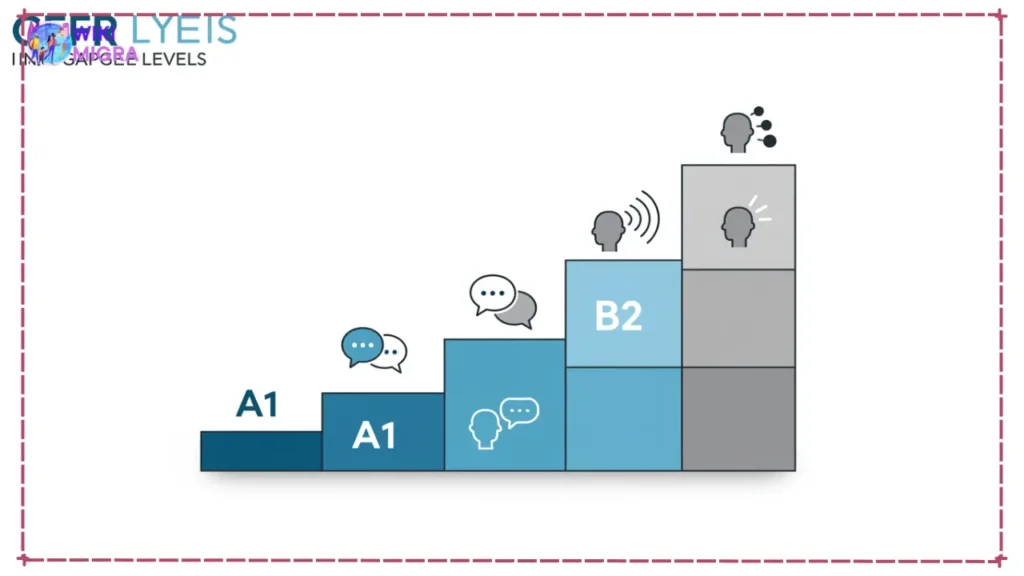
Before diving into the specifics of the Opportunity Card language requirements, it’s vital to grasp what language levels like German A1 level, German B2 level, and C1 truly represent. These are benchmarks from the Common European Framework of Reference for Languages (CEFR), a global standard for describing language proficiency.
Consider this practical breakdown:
- A1 (Beginner – Basic German for Visa):
- Practical Terms: You can understand and use familiar everyday expressions and basic phrases for concrete needs. You can introduce yourself and others, ask and answer simple questions about personal details (where you live, people you know). Interaction is simple if the other person speaks slowly, clearly, and is helpful.
- In short: You possess basic survival German.
- B1 (Intermediate – Good German Knowledge):
- Practical Terms: You can grasp main points on familiar topics in work, school, or leisure. You can handle most travel situations in German-speaking areas. You can produce simple connected text on familiar or personal topics, describe experiences, dreams, hopes, and briefly explain opinions.
- In short: You manage most daily interactions and can express yourself on known subjects.
- B2 (Upper Intermediate – Professional German B2 Level / Fluent English B2 for German Visa):
- Practical Terms: You comprehend complex texts on concrete and abstract topics, including technical discussions in your field. You interact with fluency and spontaneity, making regular conversation with native speakers possible without strain for either party. You produce clear, detailed text on diverse subjects and explain viewpoints on topical issues.
- In short: You communicate effectively and spontaneously in most professional and social settings, crucial for roles requiring a strong German B2 level or English B2 for German visa purposes.
- C1 (Advanced – Excellent German Knowledge):
- Practical Terms: You understand demanding, longer texts and recognize implicit meanings. You express yourself fluently and spontaneously without much searching for words. You use language flexibly for social, academic, and professional purposes. You produce clear, well-structured, detailed text on complex subjects.
- In short: Highly proficient, handling complex language tasks with ease.
Understanding these distinctions is paramount because the Opportunity Card sets a minimum language requirement and then awards points for higher German language proficiency, directly impacting your Opportunity Card language requirements score.
You may be interested in: Proof of Financial Means Germany Visa: Complete Guide for Opportunity Card Applicants
Minimum Language Requirement for the Opportunity Card: German A1 OR English B2
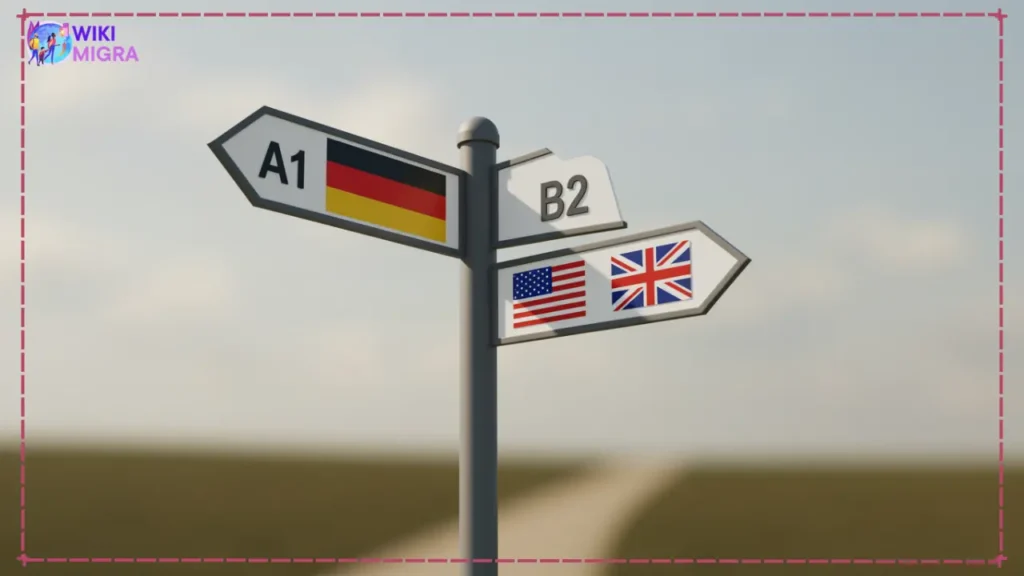
This is a pivotal aspect of the Opportunity Card language requirements: you do NOT exclusively need German to meet the minimum language threshold. You have an option:
- Demonstrate basic German skills at German A1 level (CEFR), OR
- Show good English skills at English B2 level (CEFR). This option makes English B2 for German visa applications a viable route.
Let’s detail what each means for your Chancenkarte application.
Proving Your German A1 Level for the Visa
Achieving a German A1 level certificate signifies your initial commitment to the German language. For the Opportunity Card, this fulfills a key part of the Opportunity Card language requirements if you opt for the German language route.
- Daily Life: Handle basic interactions: ordering food, asking for directions, simple introductions.
- Job Search: While a German A1 level isn’t sufficient for most professional roles, it signals to employers your willingness to learn.
- Visa Prerequisite: Satisfies the minimum language element of the Opportunity Card language requirements if you don’t present B2 English.
Accepted Certificates for German A1 (Proof of A1 German):
To validate your German A1 level, an official certificate from a recognized testing body is mandatory. Commonly accepted for Opportunity Card language requirements are:
- Goethe-Zertifikat A1: From the Goethe-Institut.
- telc Deutsch A1: From telc GmbH.
- ÖSD Zertifikat A1: From the Österreichisches Sprachdiplom Deutsch (ÖSD).
- (Note on TestDaF): TestDaF is generally for higher levels (B2-C1) and academic purposes, not typically used for German A1 level proof.
“My Goethe A1 certificate was a key part of my Opportunity Card application. Focusing on practical phrases for the German A1 level test made my initial days in Germany much smoother!” – Opportunity Card Holder.
Validating Your English B2 for German Visa Applications
If your German isn’t yet at A1, or if you’re more proficient in English, proving English B2 for German visa purposes is an equally valid path for the Opportunity Card language requirements. This is especially relevant for international companies or sectors like IT where English is prevalent.
- Daily Life & Work: Understand complex texts, engage in field-specific discussions, communicate fluently. Essential for international work environments in Germany.
- Job Search: Many German tech companies, research institutions, and multinationals use English. An English B2 for German visa certificate makes you a strong candidate.
- Visa Prerequisite: Fulfills the minimum language component of the Opportunity Card language requirements if A1 German isn’t provided.
Accepted Certificates for English B2 (e.g., IELTS for German Opportunity Card, TOEFL for Chancenkarte):
Official certification is required:
- TOEFL iBT: Score equating to B2 (typically 72-94). Check ETS TOEFL.
- IELTS Academic or General Training: Band 5.5 – 6.5 is generally B2. Verify via IELTS. (Many ask: “Is IELTS accepted for German visa?” Yes, for this purpose.)
- Cambridge English Qualifications: B2 First (FCE) or higher. See Cambridge English.
Summary: Minimum Language Proof for Opportunity Card Language Requirements:
| Language Requirement Category | CEFR Level | Accepted German Certificates for German A1 level | Accepted English Certificates for English B2 for German visa |
| Option 1: German Skills | A1 (Basic) | Goethe-Zertifikat A1, telc Deutsch A1, ÖSD Zertifikat A1 | N/A |
| Option 2: English Skills | B2 (Good) | N/A | TOEFL iBT (B2 equiv.), IELTS (Band 5.5-6.5), Cambridge B2 First+ |
Data Insight: Our analysis shows that job seekers targeting roles in Germany’s major tech hubs (Berlin, Munich, Hamburg) often leverage the English B2 for German visa option, as over 60% of tech startups list English as a working language. This directly impacts their approach to the Opportunity Card language requirements.
You may be interested in: In-Depth: Germany Opportunity Card Points System Calculator & Detailed Breakdown
Gaining Points for Higher German Language Skills (A2, B1, B2, C1)
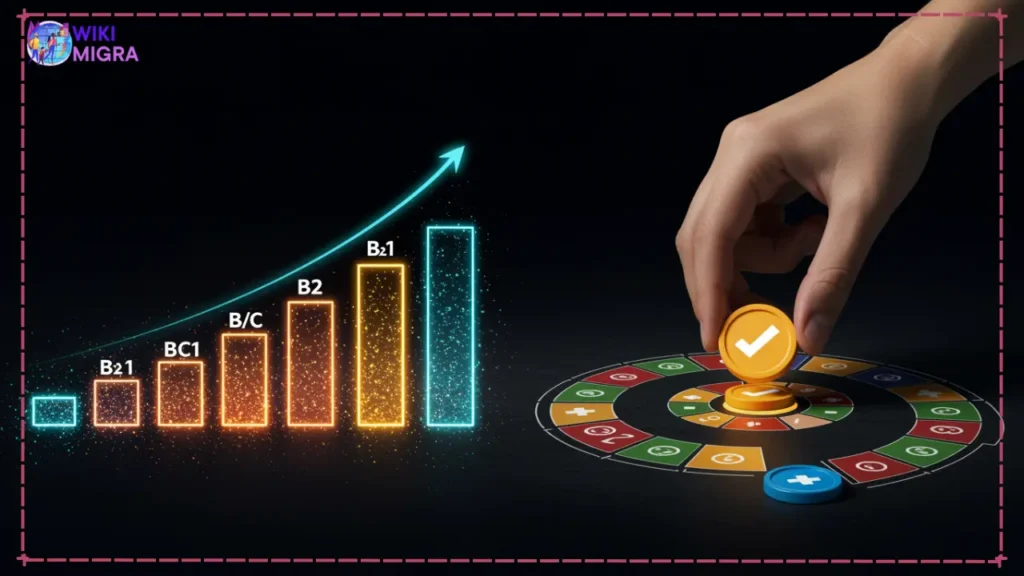
Meeting the minimum Opportunity Card language requirements (A1 German OR B2 English) is the baseline. The Chancenkarte uses a points system, and showcasing higher German language proficiency—beyond the basic German A1 level—earns valuable points.
Crucially, these points are specifically for German language skills. While B2 English satisfies basic entry, advancing your German (e.g., to a German B2 level) is key to maximizing points in the language category of the Opportunity Card language requirements.
Here’s how different German levels can boost your points (verify with official sources like Make it in Germany for precise, current figures):
- German A2 (Sufficient knowledge – ausreichende Deutschkenntnisse):
- Practical Benefits: Understand frequently used expressions on immediate relevance (basic personal info, shopping, employment). Communicate in simple, routine tasks.
- Points Awarded for Opportunity Card: Typically 1 point. Signals progress beyond the initial German A1 level.
- German B1 (Good knowledge – gute Deutschkenntnisse):
- Practical Benefits: More independent. Understand main points on familiar matters. Handle most travel situations. Produce simple connected text. A good target for initial jobs requiring some German.
- Points Awarded for Opportunity Card: Generally 2 points. A significant step, showing solid intermediate German for the Opportunity Card language requirements.
- German B2 (Very good knowledge / Business fluent – gute Deutschkenntnisse / beruflich relevante Deutschkenntnisse):
- Practical Benefits: Often considered professional fluency. Understand complex texts, technical discussions in your field. Interact fluently with native speakers. Unlocks a wider job range. Achieving a German B2 level is highly advantageous.
- Points Awarded for Opportunity Card: Proving a German B2 level usually grants 3 points. This offers a substantial boost to your application.
- German C1 (Excellent knowledge / Near-native – sehr gute Deutschkenntnisse):
- Practical Benefits: Understand demanding, longer texts. Express fluently and spontaneously. Use language flexibly for social, academic, professional purposes. Often for highly skilled roles.
- Points Awarded for Opportunity Card: C1 German typically awards the maximum language points (often 4 points), satisfying the highest tier of Opportunity Card language requirements for points.
How to Prove These Higher German Levels (e.g., German B2 Level Test):
The same accredited institutions offer exams:
- Goethe-Zertifikat: B1, B2, C1 (e.g., Goethe-Zertifikat B2)
- telc Deutsch: B1, B2, C1 (e.g., telc Deutsch B2)
- ÖSD Zertifikat: B1, B2, C1
- TestDaF: Pegged at B2-C1 levels. TestDaF score TDN 3 in all sections is often B2, TDN 4 is B2/C1, TDN 5 is C1. A popular German B2 level test for academic and professional routes.
Personalized Recommendation: If you already meet the English B2 for German visa minimum, focus your efforts on achieving at least German A2 or B1 to gain those extra Chancenkarte points. If starting from scratch, assess if A1 German or B2 English is quicker for the minimum Opportunity Card language requirements, then plan German studies for points.
You may be interested in: Navigating German Professional Qualification Recognition (Anabin & ZAB Guide)
Tips for Learning German/Improving English for Visa Language Proof
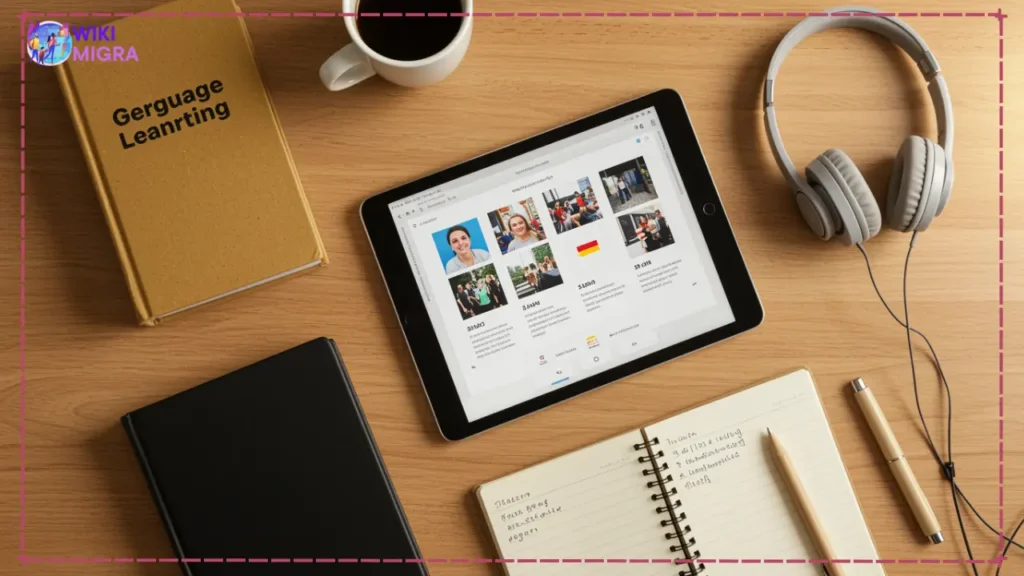
Whether aiming for the German A1 level, pushing for a German B2 level, or certifying English B2 for your German visa, here are tips:
For Learning German (Targeting German A1 level, German B2 level, etc.):
- Structured Courses: Goethe-Institut (worldwide/online), Volkshochschulen (VHS) in Germany, private language schools.
- Language Apps (Supplementary): Duolingo, Babbel, Memrise are useful for vocabulary but not official proof for Opportunity Card language requirements.
- Tandem Partners: Practice speaking via Tandem, HelloTalk.
- Immersion: German phone language, DW Learn German, German TV/movies/podcasts.
- Exam Prep: Focus on Goethe, telc, or TestDaF exam formats. Understand the German B2 level test structure if that’s your goal.
For Improving/Certifying English (Targeting English B2 for German Visa):
- Assess Current Level: Online placement tests.
- Official Test Prep Materials: Use official TOEFL, IELTS, Cambridge guides. Essential for meeting the English B2 for German visa standard.
- All Four Skills: Practice Reading, Writing, Listening, Speaking.
- Academic English: Many B2 tests include academic content.
- Mock Tests (Timed): Crucial for time management.
Pro Tip: Daily, consistent study (even 30 mins) is more effective for meeting the Opportunity Card language requirements than infrequent long sessions.
Is A1 Required for a German Visa?
To determine whether the A1 level of German language proficiency is required for a German visa, it is essential to consider the specific visa category and individual circumstances. The requirement for an A1 certificate depends on the purpose of your stay in Germany, as well as the type of visa you are applying for. Below is a detailed explanation based on authoritative sources:
Understanding A1 Language Proficiency
The A1 level of German language proficiency, as defined by the Common European Framework of Reference for Languages (CEFR), represents basic language skills. At this level, individuals can understand and use simple phrases and sentences related to everyday situations. They can introduce themselves, ask and answer questions about personal details, and interact in a limited way if the other person speaks slowly and clearly.
When is A1 Required?
Family Reunion Visa
For non-EU spouses applying for a family reunion visa to join their partner in Germany, an A1 German language certificate is often required. This requirement ensures that spouses have basic communication skills to integrate into German society. However, there are exceptions:
- If the spouse already residing in Germany holds certain types of residence permits or visas (e.g., under §§ 30 or 32 of the German Residence Act), the A1 certificate may not be mandatory.
- Each case is reviewed individually by visa officers.
Employment Visas
For employment-related visas, such as those involving recognition of foreign qualifications or employment within a recognition partnership framework, applicants may need to demonstrate at least an A2 level of proficiency. In these cases, an A1 certificate alone would not suffice.
Student Visas
A student visa typically requires higher levels of proficiency (B2 or above) depending on the university and program requirements. Therefore, an A1 certificate is not relevant for this category.
Permanent Residency and Naturalization
While not directly tied to obtaining a visa, achieving permanent residency or naturalization in Germany after several years often requires B1-level proficiency. An A1 certificate would not meet this standard.
Exceptions to the Requirement
There are notable exceptions where an A1 certificate may not be necessary:
- Spouses joining highly skilled professionals or specialists working in Germany.
- Applicants from countries with bilateral agreements that waive language requirements.
- Cases where applicants can demonstrate integration through other means (e.g., prior education or work experience in Germany).
How to Obtain an A1 Certificate
To obtain an A1 certificate:
- Take a recognized test at institutions like the Goethe-Institut.
- The exam evaluates listening, reading, writing, and speaking skills at a basic level.
In conclusion: Whether an A1 German language certificate is required for a German visa depends on the specific type of visa being applied for. It is mandatory for certain categories like family reunion visas but may not be needed for others such as student visas or some employment visas where higher levels are required. Exceptions exist based on individual circumstances and legal provisions.
What is A1, A2, B1, B2, C1, C2 in German language?
Understanding A1, A2, B1, B2, C1, C2 in German Language:
The levels A1, A2, B1, B2, C1, and C2 are part of the Common European Framework of Reference for Languages (CEFR). This framework is an internationally recognized standard used to measure and describe language proficiency. It was developed by the Council of Europe to provide a consistent way to assess and compare language skills across different languages. These levels are divided into three main categories: Basic User (A), Independent User (B), and Proficient User (C). Each category is further subdivided into two levels.
Below is a detailed explanation of each level in the context of learning German:
A1: Beginner Level
This is the most basic level of language proficiency and is often referred to as the “breakthrough” stage.
- What you can do at this level:
- Understand and use familiar everyday expressions and very basic phrases aimed at satisfying concrete needs.
- Introduce yourself and others.
- Ask and answer questions about personal details such as where you live, people you know, and things you have.
- Interact in a simple way if the other person speaks slowly and clearly.
- Time required: Typically requires 60–150 hours of study with structured instruction.
A2: Elementary Level
This level is also known as the “waystage” or pre-intermediate stage.
- What you can do at this level:
- Understand frequently used expressions related to areas of immediate relevance (e.g., shopping, local geography, employment).
- Communicate in simple tasks requiring direct exchange of information on familiar topics.
- Describe aspects of your background, immediate environment, and matters in areas of immediate need using simple terms.
- Time required: Usually takes around 150–250 hours of study.
B1: Intermediate Level
This marks the beginning of being an independent user. It’s often referred to as the “threshold” stage.
- What you can do at this level:
- Understand the main points when clear standard language is used on familiar topics like work, school, or leisure.
- Deal with most situations likely to arise while traveling in a German-speaking area.
- Produce simple connected text on topics that are familiar or personally interesting.
- Describe experiences, events, dreams, hopes, ambitions; briefly give reasons or explanations for opinions or plans.
- Time required: Reaching this level typically requires between 250–500 hours of study.
B2: Upper-Intermediate Level
At this stage, learners are considered fluent enough for most practical purposes. This is often referred to as the “vantage” stage.
- What you can do at this level:
- Understand the main ideas of complex texts on both concrete and abstract topics.
- Interact with native speakers fluently without strain for either party.
- Produce clear detailed text on a wide range of subjects.
- Explain viewpoints on topical issues giving advantages and disadvantages.
- Time required: Achieving B2 proficiency may take around 450–600 hours, though some learners reach it faster depending on their dedication.
C1: Advanced Level
This represents advanced proficiency where users can operate effectively in professional or academic settings.
- What you can do at this level:
- Understand a wide range of demanding texts with implicit meaning.
- Express ideas fluently without much searching for expressions.
- Use language flexibly for social, academic, or professional purposes.
- Produce well-organized detailed text on complex subjects showing controlled use of organizational patterns.
- Time required: Typically requires around 600–750 hours to achieve this advanced skill set.
C2: Mastery Level
This is the highest CEFR level representing near-native fluency. It’s often called “proficiency.”
- What you can do at this level:
- Easily understand virtually everything heard or read.
- Summarize information from different spoken/written sources coherently.
- Express yourself spontaneously with precision even in complex scenarios such as academic discussions or technical debates.
- Time required: Achieving mastery usually takes over 750–1000+ hours, depending on individual aptitude.
Summary Table
| CEFR Level | Description | Skills Acquired | Time Required |
|---|---|---|---|
| A1 | Beginner | Basic phrases; introduce yourself; ask/answer simple questions | ~60–150 hrs |
| A2 | Elementary | Frequently used expressions; describe background/family; order food | ~150–250 hrs |
| B1 | Intermediate | Handle travel situations; discuss hobbies/work/school | ~250–500 hrs |
| B2 | Upper Intermediate | Fluent conversations; write/read complex texts | ~450–600 hrs |
| C1 | Advanced | Confident communication in professional/social settings | ~600–750 hrs |
| C2 | Mastery | Near-native fluency; understand almost everything | ~750+ hrs |
Importance
The CEFR levels are widely recognized by educational institutions and employers worldwide. They provide a standardized way to assess language skills objectively. For example:
- Many universities require students to have at least a B2-level proficiency for admission into programs taught in German.
- Certain professions may demand higher levels like C1 or even C2 for roles involving technical discussions or teaching.
A1 through C2 represent progressive stages in mastering German under the CEFR framework—from beginner (A) through independent user (B) to proficient user (C). Each level corresponds to specific linguistic abilities that increase in complexity as learners advance.
What language is required for German visa?
What language is required for a German visa?
The required level of German language proficiency depends on the type of visa you are applying for:
- Tourist and Business Visas: No German language proficiency is required.
- Work and Freelance Visas: Generally, no specific German language requirement exists, but knowledge of German may be necessary to demonstrate the viability of your business or job-seeking plans. For a job-seeker visa, at least B1 level is required.
- Student Visa: No specific German requirement for the visa itself, but universities often require B2 or C1 proficiency depending on the program unless it is taught in English.
- Family Reunion Visa: A basic A1 level of German is typically required for spouses joining their partners in Germany. Children over 16 may need higher proficiency to integrate into education and society.
- Language Course Visa: Admission to an intensive course (minimum 18 hours per week) is mandatory; prior knowledge of German may be needed if starting above A1 level.
What level of language is B2 German?
B2 German is the upper-intermediate level in the Common European Framework of Reference for Languages (CEFR). At this level, learners can understand complex texts on both concrete and abstract topics, communicate fluently and spontaneously with native speakers without significant effort, and express opinions clearly on a variety of subjects. It is often considered the threshold for fluency and is sufficient for professional communication or studying at many universities in Germany.
FAQ: Specific to Opportunity Card Language Requirements
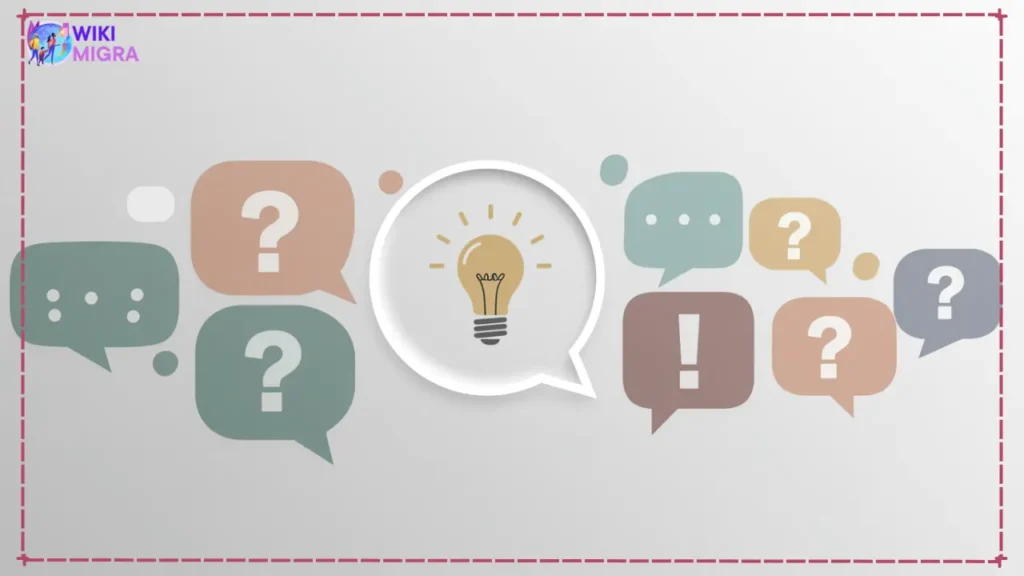
Common questions about German visa language proof for the Chancenkarte:
- “Is Duolingo enough for German A1 level proof?”
- No. Duolingo isn’t an officially recognized certificate for Opportunity Card language requirements. You need a Goethe, telc, or ÖSD certificate for your German A1 level.
- “My university course was in English; is that proof of English B2 for German visa?”
- Sometimes, but verify. If your entire degree was exclusively taught and examined in English, some German missions may accept university confirmation as proof of English B2 for German visa purposes. However, this isn’t universal. An official TOEFL, IELTS, or Cambridge B2 certificate is safer for the Opportunity Card language requirements. Always check with the German mission in your country via the German Federal Foreign Office.
- “How old can my language certificate be for the Opportunity Card?”
- Generally, certificates for Opportunity Card language requirements (like German A1 level or English B2 for German visa) should ideally be not older than one to two years. While some (like Cambridge) don’t expire, visa offices prefer recent proof. Goethe, telc, TOEFL, IELTS are usually valid for two years.
- “Can I get points if I have German A1 AND English B2?”
- You meet the minimum Opportunity Card language requirements with either. If you use B2 English for the minimum, your German A1 level (or A2, B1, German B2 level) then will count towards points for German language skills.
- “If I provide a German B2 level certificate, do I also need A1?”
- No. A higher certificate (e.g., German B2 level) inherently proves mastery of lower levels (like German A1 level). It fulfills the requirement and earns more points for the Opportunity Card language requirements.
Conclusion: Proactive Language Learning for Your German Opportunity Card Success
The Opportunity Card language requirements ensure you can navigate basic German life (with a German A1 level) or function in English-speaking professional settings (with English B2 for German visa proof). While this minimum opens the door, striving for higher German language levels (B1, German B2 level, or C1) significantly strengthens your Chancenkarte application by awarding more points.
More importantly, strong German skills are invaluable for your job search, integration, and truly experiencing Germany. Don’t view learning as just fulfilling Opportunity Card language requirements; it’s an investment.
- More questions on Opportunity Card language requirements? Comment below!
Start your language journey today for your German dream! Viel Erfolg!





